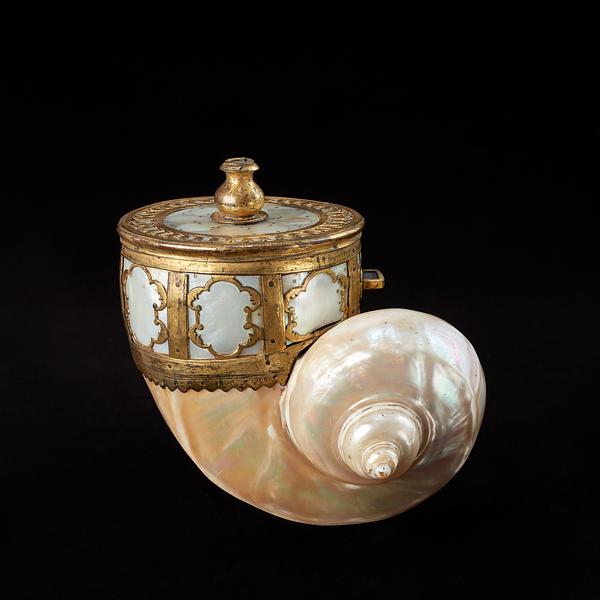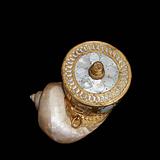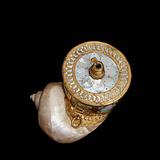Powder horn made of a conch shell extended with mother-of-pearl, gilt copper and possibly wood
India, Gujarat; 17th century
Maximum H: 15.2 cm
This powder horn is made of a conch shell whose outer calcareous layer has been sanded down to expose its inner layer of reddish mother-of-pearl. To increase the volume of the horn, the conch shell has been extended upwards with panels of mother-of-pearl framed by gilt copper. The construction is presumably reinforced by an inner wooden structure. At the top is a circular cover with inlaid floral decorations in mother-of-pearl and a small, baluster-shaped spout with a sliding lid.
The horn would have contained a considerable amount of gunpowder, which could be poured down the barrel of a muzzle-loading gun via the spout. In addition to this horn, the gunner would also have carried a smaller powder flask with very finely grained gunpowder to be used as a primer (
1/1974,
31/1987).
The conch shell is that of the seasnail
turbo marmoratus. The species is found in the Indian Ocean, and its shells have long been collected along the west coast of India for the sake of its mother-of-pearl. From the sixteenth century onwards, Gujarat was particularly famous for its mother-of-pearl items (
22/1983,
35/1976), which were exported to the rest of the Islamic world and to Europe, where Indian mother-of-pearl was an exotic feature in many princely collections.
Inv. no. 36/1980
Published in:
Spink & Son: Islamic art from India, London 1980, p. 69, cat.no. 90;
Vibeke Woldbye and Bettina von Meyenburg (eds.): Konkylien og mennesket: udstilling i Kunstindustrimuseet, Copenhagen [1983), cat.no. 87, p. 108;
Kjeld von Folsach: Islamic art, The David Collection, Copenhagen 1990, cat.no. 288;
Kjeld von Folsach: Art from the World of Islam in The David Collection, Copenhagen 2001, cat.no. 415;
Kjeld von Folsach, Joachim Meyer and Peter Wandel: Fighting, Hunting, Impressing. Arms and Armour from the Islamic World 1500-1850, The David Collection, Copenhagen 2021, cat.no. 50;



